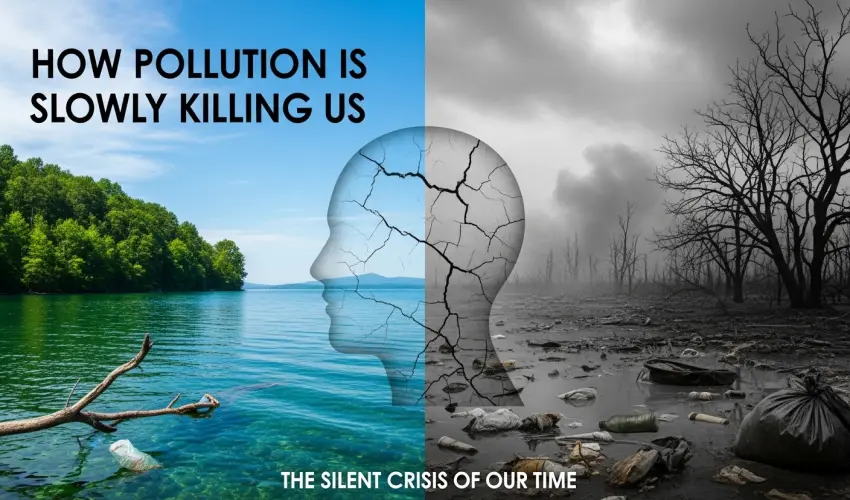How Pollution is Slowly Killing Us: The Silent Crisis of Our Time
Published Apr 30, 2025
1 0
Key Takeaways
-
Pollution—air, water, soil, noise, and light—directly impacts human health, causing millions of premature deaths each year.
-
Air pollution is the deadliest form, contributing to respiratory diseases, heart conditions, and cognitive decline.
-
Polluted water and contaminated soil result in food insecurity, gastrointestinal diseases, and long-term organ damage.
-
Industrialization, urbanization, and modern lifestyle choices are intensifying pollution's reach and toxicity.
-
Addressing pollution requires global cooperation, strong policy changes, and individual responsibility to safeguard future generations.
Introduction: The Invisible Threat in Plain Sight
Every breath you take, every glass of water you drink, every bite of food you consume—chances are, they’re laced with invisible toxins. Pollution isn’t just dirtying the planet; it’s slowly, silently killing us.
Unlike dramatic disasters or pandemics, pollution doesn’t create headlines every day. But its effects are far more insidious, infiltrating every aspect of our lives and health. From the air in megacities to the water in rural towns, pollution is the deadliest environmental risk to humanity today. Let’s explore how it’s happening, why it matters, and what can still be done to fight back.
The Global Toll: Pollution by the Numbers
The data is staggering. According to the World Health Organization (WHO) and the Lancet Commission on Pollution and Health:
-
Pollution causes over 9 million premature deaths annually—that’s 1 in every 6 deaths worldwide.
-
Air pollution alone accounts for 7 million of those deaths.
-
Low- and middle-income countries bear the highest burden, but no one is truly immune.
1. Air Pollution: The Deadliest Killer in the Sky
Air pollution is perhaps the most immediate and inescapable threat. It comes from vehicle emissions, industrial waste, construction dust, and household fuels like coal or wood.
The Most Dangerous Pollutants:
-
PM2.5: Tiny particles that enter the lungs and bloodstream, linked to heart attacks, asthma, strokes, and lung cancer.
-
Nitrogen Dioxide (NO₂) and Sulphur Dioxide (SO₂): Gasses that trigger severe respiratory problems.
-
Ground-Level Ozone (O₃): Causes chest pain and reduced lung function.
Health Effects:
-
Worsens asthma and COPD.
-
Increases the risk of cardiovascular disease.
-
Affects brain development in children and contributes to dementia in adults.
2. Water Pollution: Poison in Every Drop
Contaminated water is a global crisis fueled by industrial discharge, agricultural runoff (pesticides, fertilizers), plastic waste, and untreated sewage.
Health Effects:
-
Gastrointestinal infections like cholera and dysentery.
-
Heavy metal poisoning from lead, mercury, and arsenic.
-
Hormonal disruptions from endocrine-disrupting chemicals.
-
Increased cancer risk from long-term exposure to industrial toxins.
Children are especially vulnerable, as even low levels of toxins can permanently damage their developing organs and brains.
3. Soil Contamination: The Polluted Plate
Soil pollution is a silent threat to our food security. Toxins from pesticides, industrial spills, and e-waste dumping seep into the soil and are absorbed by crops, entering our food chain undetected.
Health Effects:
-
Nervous system disorders.
-
Reproductive health issues.
-
Immune system suppression.
-
Cancer from carcinogenic compounds like cadmium and lead.
4. Noise Pollution: The Unseen Aggravator
Often dismissed as a mere "disturbance," noise pollution from traffic, construction, and industry has very real health implications.
Health Effects:
-
Hearing loss and tinnitus.
-
Sleep disturbances and chronic stress.
-
Increased blood pressure and risk of heart disease.
-
Cognitive impairment in children and increased anxiety in adults.
5. Light Pollution: The Disrupted Rhythm of Life
Excessive artificial lighting at night disrupts human biology in subtle but significant ways by affecting melatonin production and our natural circadian rhythm.
Health Effects:
-
Sleep disorders and insomnia.
-
Increased risk of depression.
-
Links to obesity, diabetes, and certain types of cancer.
Who Is Most at Risk?
While pollution affects everyone, certain groups face greater danger:
-
Children: Their developing organs are more susceptible to toxins.
-
Pregnant Women: Toxins can cross the placenta, affecting fetal development.
-
The Elderly: Pre-existing conditions make them more vulnerable.
-
Low-Income Populations: Often live near industrial zones with higher pollution levels.
-
Outdoor Workers: Have prolonged exposure to harmful pollutants daily.
Can We Fix It? Solutions Within Reach
Yes, but it will take bold policies, innovation, and collective action.
-
Cleaner Energy: Transitioning to renewable energy (solar, wind, hydro) is the single most effective step.
-
Green Transportation: Invest in public transit, electric vehicles, and cycling infrastructure.
-
Smarter Agriculture: Reduce pesticide use, promote organic farming, and manage livestock waste.
-
Stronger Regulations: Governments must enforce strict pollution limits and penalize violators.
-
Public Awareness and Action: Simple acts like reducing plastic use, conserving water, and planting trees make a huge collective impact.
Conclusion: The Clock Is Ticking
Pollution isn’t always visible, but its effects are all around us—in the wheeze of a child with asthma, the poisoned rivers, and the rising rates of chronic disease. It’s a slow-motion emergency, and every day we delay, the cost in lives and ecosystems climbs.
The good news? We still have time. With science, policy, and public commitment, we can clean our air, purify our water, and heal our soil. We owe it not just to ourselves, but to all future generations.








